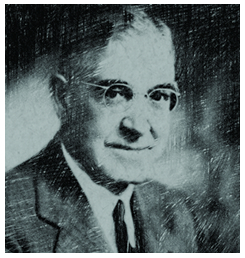- Home
 About us
About us  About the Founder
About the Founder
About the Founder
 Dr. Sam Higginbottom
A farmer
A teacher
A servant of God
Dr. Sam Higginbottom
A farmer
A teacher
A servant of God
Sam Higginbottom, the founder of Allahabad Agricultural Institute belongs to this category of leaders. Born in 1874 in a humble family in England and brought up in very indigent rural circumstances, Sam acquired school education by supporting himself and his studies by selling milk and doing other odd income-generating jobs. Later he migrated to the United States and pursued theological studies with the objective of becoming a missionary, to go to Latin America, Africa or China as was wont in those days of active evangelization of the colonized nations. By a strange turn of destiny, finally Higginbottom was assigned to India, especially the district of Etah in the present Uttar Pradesh, by his superior of the Presbyterian Church, North India Mission. Again by an unexpected change he was re-routed to Allahabad, the then capital of the Central Provinces under the British rule. At the age of 29 in 1903 Sam arrived at Allahabad and joined the Allahabad Christian College located on banks of Yamuna river near Sangam, the confluence of Ganga, Yamuna and the legendary river Saraswati which had dried up long ago.
Sam began his career as a teacher of economics and tried innovative methods of problem-solving, teaching and learning. His mind was deeply disturbed by the abysmal poverty of the farmers in the neighboring villages and districts, where the land was barren and agriculture was of very low productivity. He realized that his mission in life would be improving the plight of the Indian farmers through modern agriculture. He decided to set up an agriculture school near Sangam in Naini with the help of his wife Ethelind. The courses offered included agricultural engineering, dairy technology, animal husbandry, high-yielding seed production and farm management.
The Young Samaritan
A century ago, a young American in his late 20s stood on the southern banks of the Yamuna near the holy Triveni confluence at Allahabad, contemplating a patch of badly eroded soil, which had not been tilled for centuries. He looked at the neighbouring farms' poor crops and famished livestock. As he surveyed the scene he was convinced that the only way India could progress was through modernization of agriculture. He resolved to do something about it. This young man was Dr. Sam Higginbottom, a teacher whose birth date always recalls a life dedicated to that resolve.
The Decision
He became a familiar figure in the surrounding villagesand observed the living conditions and agricultural Practices of the villagers. He was deeply concerned about the ancient system of agriculture which contributed to low productivity and thus led to extreme poverty amongst them. He was also genuinely disturbed by the vast gulf between the urban Christians and the rural masses. For several months he contemplated upon the Christian neglect of the villages and ultimately by the end of 1909 he decided to bridge this gulf by establishing an agricultural school, which he envisioned would educate the village boys, introduce improved agricultural methods and co-operate with the local farmers in solving their practical agriculture related problems. The evolution of an agricultural school was much more complex. Dr. Sam Higginbottom wished to establish a school that would train young men to work in villages as well as do research in practical agricultural problems of the villagers. His experiences as a teacher in economics and later in agriculture, his studies about India and his association with Col. Hudson, Superintendent, Naini Jail helped him to develop this school. 1910 was the year of decision when Agricultural Institute was established under the leadership of Dr. Sam Higginbottom, as an ecumenical Institution of the ChristianChurches and Church organizations in India.
Convinced that India could only progress by modernizing agriculture, Dr. Sam Higginbottom, a young American teacher, raised funds in the United States to install Allahabad Agricultural Institute. Over first four decades the institute has done pioneering work for the advancement of agriculture,including introducing pest-resistant high yielding-seeds,improved farm implements and extension programs for farmers under the leadership of Dr.SamHigginbottom.
The Mission
The gift of Bible sparked in him the desire to seek education at Mount Hermon in the United States, the country that he adopted. Completing High School at age 24, Higginbottom worked his way through Amherst and PrincetonUniversity for a career of helping others. A set of fortuitous events led this former cattle-puncher to accept an offer by the Presbyterian Board of Foreign Missions, New York, to teach economics at the ChristianCollege in Allahabad. However, soon after his arrival in 1903, Higginbottom discovered to his dismay that the economics that he had learned and now was to teach had no relevance and provided no clues that could relate to the Indian agrarian economy. Undeterred, he found and ingenious solution to his predicament: What better way could there be to relate the pedalogical concepts of economics to concrete reality than to take his students to nearby villages? he asked himself.
The visits to villages were revelations. The farmers used centuries-old implements and their yields, in spite of the naturally rich and fertile soil, were among the lowest in the world. The visits also defined his future to devote his life to teaching the Indian farmer progressivemethods of agriculture. He was now in his mid-30's, had no education in agriculture and owed responsibility to his wife and a growing family. But his wife, Ethelind, gave him her full support and persuaded him to go to the United States to study agriculture. Taking leave, Higginbottom returned to the United States and enrolled at the Ohio State College of Agriculture in Columbus, Ohio. During these years in United States, he assimilated as much knowledge of scientific agriculture and animal husbandry as he possibly could.
But even more than the degree that he earned, he needed financial backing for his mission. He met friends and strangers, lectured to various groups, making impassioned pleas for donations. At one meeting, he told his gathering, "It is only the abundance of America's good will, of her resources and her conspious ability to help that justify her in giving this assistance to India." He finished his lecture and waited. A young domestic servant in her teens came forward with some trepidation and handed him a $ 5 note. At another meeting, a shabbily dressed worker passed him a soiled $10 note saying, "Take this and use it for me over there." He collected $30,000 (most of it coming from donations of under $10), persuaded two American agricultural experts to join him and returned to Allahabad.
The beginning
Dr. Sam Higginbottom bought the same patch of dismal land-some 125 hectares, where he stood eight years earlier, to show that there was no land in India so bad that it could not be put under the plow. The land was reclaimed with the help of about a dozen American hillside plows. A small brick dam was constructed and soon a lush, green demonstration farm stood where nothing had grown before. The farm, which was used for giving practical training to students, excited the curiosity of neighbouring farmers, providing them their first introduction to modern farming practices. Thus was born the Allahabad Agricultural Institute (AAI), the result entirely of one man's passion and compassion. The front veranda of his residence served as a classroom-cum-lab and the back veranda as a dining-room-cum-dairy.
The Higginbottoms regularly made fund-raising trips to the United States, and with each new donation the institute grew, both in size and in the number of disciplines taught. In 1914 the government accorded recognition to his institute and sanctioned an annual grant of Rupees 20,000. From then on there was no looking back.
In the year 1926, the AAI severed its ties with the ChristianCollege and became an independent entity. The same year it started a two year diploma course in dairy farming. In 1932 it was formally affiliated with the University of Allahabad. In the same year the institute was recognized by the government for a Bachelor of Science degree in Agriculture. In 1936, perceiving the important role Indian rural women play in the house, the AAI started an intermediate course in home economics, which was later upgraded to a degree course. Another landmark came in 1942 when AAI introduced agricultural engineering - the only such course offered by an Indian university then. During his tenure, the institute's land area increased to 240 hectares and more buildings came up. AAI developed productive breeds of livestock and innovative agricultural technology; improved pest resistant seeds; and experimented with potent fertilizers and high yielding crops-all largely financed by Higginbottom's trips or, as he put it to visitors, "by the sweat of my tongue." Dr. Sam Higginbottomand AAI were soon recognized as pioneers in the development of agriculture in the country. The Higginbottoms completely identified themselves with India.
The Reinforcement
Under the guidance of Dr.SamHigginbottom, Prof. Mason Vaugh, an Agricultural Engineer, founded the Department of Agricultural Engineering. Several farm implements such as Mould Board Ploughs (WahWah Plough, U.P. No.1, U.P. No.2, Shabash Plough) also called iron ploughs, hoes, cultivators and wheat thresher were, for the first time introduced in India. The next phase of the Institute was taken up in the year 1948-49, and the major expansion such as the construction of the College of Agriculture, New Hostels and residences took place during this period. The most famous agriculture Extension Project “Jamuna Par Punaryojna”, in which the “GaonSaathi”, (recruitment of village level workers) was introduced into the extension system for the first time in India. The first planners of our country took the idea of the ‘Village Level Worker’ as a community development model. On the 25th of Aug. 1950, the AAI was registered to function as a Christian Educational Institute of a national stature.
The State Govt. of U .P. had certified that the Allahabad Agriculture Institute is a Minority Educational Institution within the meaning of clause
(i) of article 30 of the Constitution of India, vide their letter No. 4894 15-80
(ii) dated the 12th of Sept. 1980 and also certified as a Minority Institution by the U.P. Higher Education Service Commission, vide letter No. 250/ 258/83-84 dated 24/5/1983. In October 1947 the Institute was brought under an independent Board of Directors, which was sponsored as an ecumenical body by a number of Churches and Christian Missions called The Board of Directors.
Mission Accomplished
Having completed his mission for the forty years in India, Dr. Higginbottom retired and returned to the United States in 1945, two years before India got its independence, a cause which was very dear to him.
"I am anxious," he once said, "to see the day when India shall take her proper place as one of the great self-governing peoples of the world .... India's future can be richer than India's past. "I am always brooding over ways and means of avoiding this fearful waste of human life, of transforming it into a positive asset to enrich the world."Even when Higginbottom was living a retired life in the United States, his interest in India remained undiminished. He was delighted when the Indian Government gave top priority to the agricultural development in the First Five-Year Plan. That, he thought, was the greatest tribute to him and his work.
Higginbottomreturned to America in 1945 and settled in Frostproof, Florida. Higginbottom kept in close touch with developments in India until his death in 1958. During the 1950s he unsuccessfully tried to establish a Christian Service Training Center to train missionaries for agricultural work. During his lifetime Higginbottom was widely known and respected. His biographer has written that
“he embodied the ideal American representative in underdeveloped nations."

 About us
About us  Dr. Sam Higginbottom
Dr. Sam Higginbottom